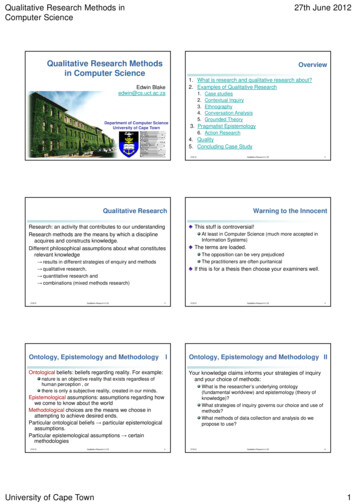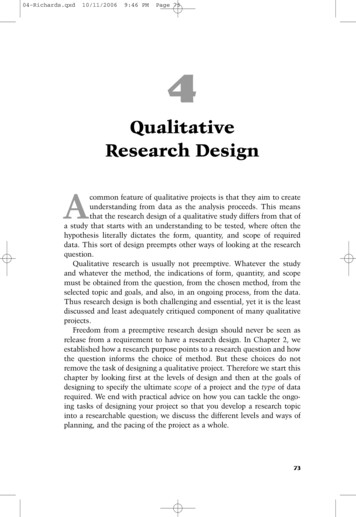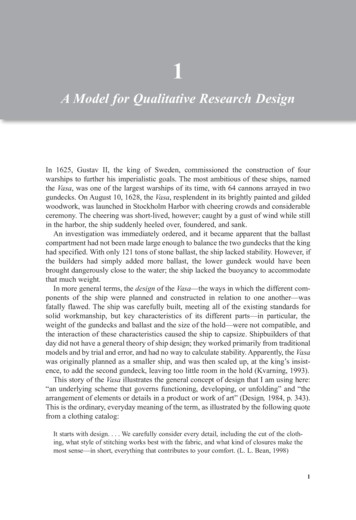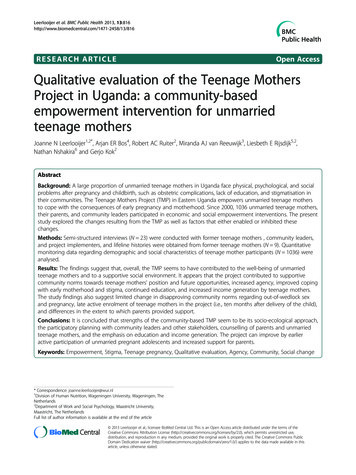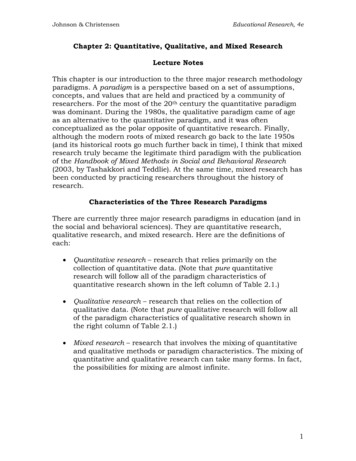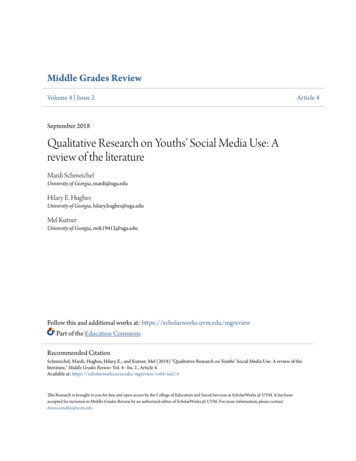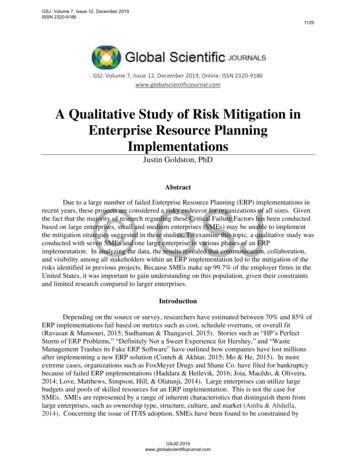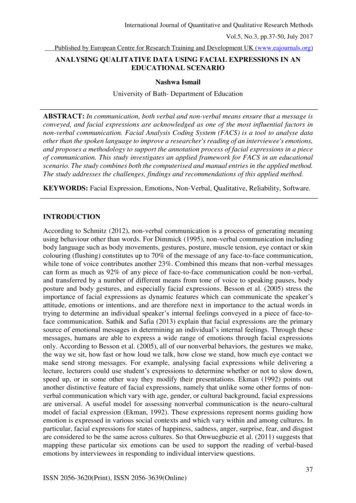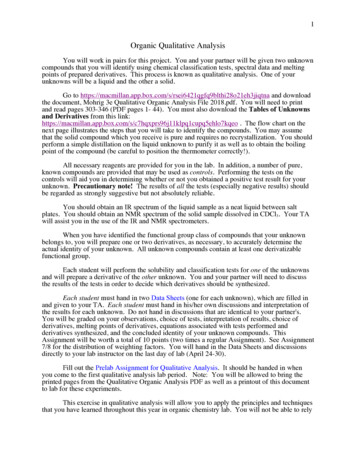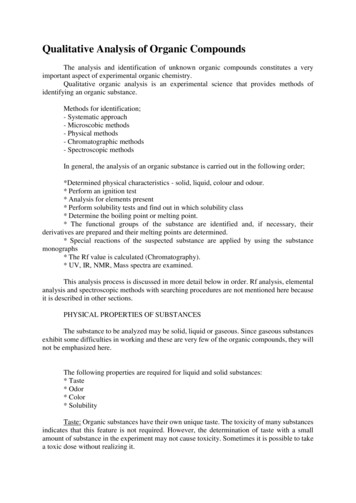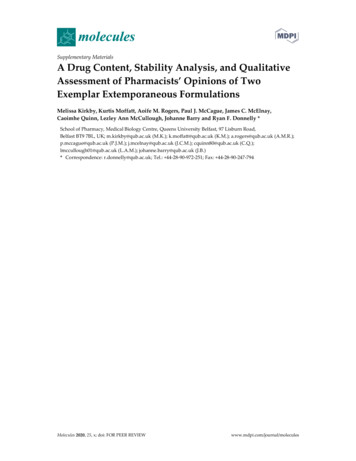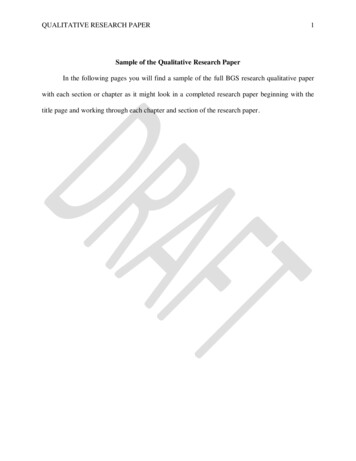
Transcription
QUALITATIVE RESEARCH PAPER1Sample of the Qualitative Research PaperIn the following pages you will find a sample of the full BGS research qualitative paperwith each section or chapter as it might look in a completed research paper beginning with thetitle page and working through each chapter and section of the research paper.
QUALITATIVE RESEARCH PAPER46Full Title of the PaperYour Full Name (as it appears on your transcript)Trinity Washington UniversityI have adhered to University policy regarding academic honesty in completingthis assignmentSubmitted to *Instructor Title and Name on behalf of the faculty of the School ofBusiness and Graduate Studies in partial fulfillment of the degree requirementsfor the Full Name of the *Degree ProgramSemester Year*Use the title Dr., or Prof. if the instructor does not have an earned doctorate. Donot use Mr. or Ms. ** For example, Master of Arts in Communication, Master ofScience Administration in Federal Programs Management.
QUALITATIVE RESEARCH PAPER45AbstractThe abstract consists of 150 to 250 words in a single paragraph, see APA 6th Publication Manualsection 2.04 for guidelines regarding items to be included. After the abstract one the same pageand starting a new paragraph are keywords, in italics, that will assist others in researchingscholarly work related to your topic. Remember there is no indent in this paragraph. Yourinstructor may determine the length of the abstract as long as it fits the parameters of no morethan 250 words. The abstract should be comprised of the following sentences:One to two sentence(s) covering the general context of the research topicOne to two sentence(s) regarding the specific research problemOne sentence regarding the research methodologyOne to two sentences regarding the significant findingsSome instructors will require a sentence regarding the conclusions and recommendationsKeywords: Include topic, major theories, keywords others might use to find your work, researchmethods.*Note that the shortened title header and page number begin here on the secondpage with page # 2. When you set up your shortened title as the header, do thaton the title page, then select different first page in the header design tab. Also,there should be no lists in an abstract. It is one solid paragraph, two if necessary.*Acknowledgements or Dedications would each have their own page followingthe abstract. *All front matter has regular, not bold, headings and the front matterdoes not appear in the table of contents.
QUALITATIVE RESEARCH PAPER45Table of ContentsPageIntroduction . 6Statement of the Problem .6Purpose of the Study .6Significance of the Study .7Theory or Theoretical Perspective .7Research Method .7Definition of Key Terms .8Delimitations .8Limitations of the Study .8Summary .9Literature Review. 10Sections . 10*Subject of Case Study . 10Review of Related Research . 11Theoretical Construct . 11Summary . 13Research Methodology. 14Research Questions . 16Setting . 18Population . 18*Data Source(s) . 19Ethical Considerations . 19Research Design . 20
QUALITATIVE RESEARCH PAPER45*Intervention Protocol . 21Interview Instrument and Protocol . 21Data Analysis Strategy . 22Summary . 23Findings . 24Participants . 24Data Analysis Strategy . 25Data Analysis and Coding . 27Summary . 31Discussion. 32Research Questions . 33Conclusions . 34Recommendations and Implications for Theory, Research, and Practice . 35Summary . 36References . 37Appendices . 38Appendix A: Recruitment Materials: English . 39Appendix B: Recruitment Materials: Español . 41Appendix C: Informed Consent Form . 43Appendix D: Survey Instrument .1*Use Heading One, primary level heading, for each chapter, and Heading Two foreach secondary level heading (indented 0.5”) for each section within the chapter.Third level and below headings do not appear in the Table of Contents. The Tableof Contents ends with the Appendices section.Use the MS Word headingfunction to establish your two heading levels and to edit how they appear in the
QUALITATIVE RESEARCH PAPER45document. Then you can use the Table of Contents builder to auto-create thetable of Contents. Microsoft Help in MS Word can assist you with learning this.List of TablesPageTable 1. Meta-codes: The three aspects of Latina women’s culture . 30List of FiguresPageFigure 1. The quantitative theoretical framework . 13*Note: you may place the list of tables and the list of figures on one page, but youshould choose to put them on separate pages if either list is extensive.
QUALITATIVE RESEARCH PAPER45IntroductionThe introduction is developed in a preamble section that is not labeled as a subsection.The introduction is developed in one to two paragraphs discussing the general context of yourresearch topic. You may recognize this as your background to the study. This is both anexpansion of your abstract and a more concise summation of your Literature Review. This willdetermine the outline of the body of the Literature Review. Think of this as an outline or athumbnail sketch of the highlights of your Literature Review. Since it is a summation of otherauthor and theorists work remember to cite heavily at the end of the paragraphs or as needed inthe text. You should plan on one to two paragraphs of general context regarding your researchtopic, which you might consider a state of world affairs briefing, at least the nation of yourresearch topic. Then provide one to two paragraphs of more specific context regarding yourtopic, this might be considered the state of your community briefing. You are preparing youraudience to understand and accept the statement of the problem.For example, you might discuss in the general context the history of synthetic marijuanause. Then in the specific context you might discuss the upsurge in synthetic marijuana use.Statement of the ProblemYou will provide one concise paragraph discussing your research problem. Be specific indescribing this problem. For example, you might discuss the problem of the recent increase insynthetic marijuana use among preteens in Northwest DC and the resulting risks to their healthand lifestyle. Remember you have prepared the reader with the preamble above this section.Purpose of the StudyDiscuss in one paragraph what you will do in the research. This is made obvious in theargument of the Literature Review. This is a brief statement of how you will investigate the
QUALITATIVE RESEARCH PAPER45research problem. For example, the purpose of this study is to examine the prevalence of the useof synthetic marijuana use among preteens which will lead to a prevention and interventionmodel to be used in community centers citywide.Significance of the StudyDiscuss what the benefit will be of addressing the research problem might be to thepopulation of your study, the academic community.For example, Health professionals,educators, staff members, and concerned citizens will have relevant information and anintervention model they might make use of to curb preteen use of synthetic marijuana.Theory or Theoretical PerspectiveA brief discussion of the theory your quantitative research study is investigating, or abrief discussion of the theoretical perspective of your qualitative research. You might have aspecific rationalist or modernist theory that describes cause and effect and you would discuss thattheory. Or you might perceive this problem to be a result of a social construction in thediscourse between parents and children and you would discuss social constructionism, or theconversations in society concerning the benefits of rebellious individualism. So you woulddiscuss the theories of hegemonic language and the process of de-centering the discourse tochange the source of power in the discourse. In another example, you might compare the fivecommon health behavioral models to the results of the study and suggest my own interventionmodel. So you would discuss the overarching theoretical field of behavioral change.Research MethodA concise paragraph describing the research method used to investigate the problem.This can later be expanded into the preamble of your research methods chapter.Cite thetextbooks and research articles, which inform you. Creswell’s Research Design, 3rd or 4th ed.
QUALITATIVE RESEARCH PAPER45Have great discussions of quantitative research methods and useful checklists. Additionally,language from Merriam’s, Qualitative Research, can be helpful.Definition of Key TermsKeep this brief, if extensive a glossary is required, which would belong in the appendicesEach definition appears as a third level heading in this section. Cite the sources of yourmaterials. For example:De-centering: a means of changing the power of negative or oppressive words andphrases that hegemonic cultures subconsciously use to impose and maintain the powerrelationships in the cultures as defined and proposed by Jacques Derrida (Hatch & Cunliffe,2006, p. 311).And so on DelimitationsMost research topics cover areas that are far too multitudinous, multifaceted, complex, orinexhaustible to be addressed in a research study of any scope, say nothing of an undergraduateor a graduate level research paper.There are research directions and research questionssuggested by your research topic but are not addressed in this research study. Discuss a few ofthese to show that you know where your research fits in its scholarly community and that youknow what you can accomplishLimitations of the StudyDescribe what your research design cannot accomplish due to the scope of the project,limitations of time and resources. However, do not adopt a whiny and petulant tone; you aresimply acknowledging reality, as does every other student in your position. For example, Due tothe scope of this research project you are not able to collect data from the entire recommended
QUALITATIVE RESEARCH PAPER45population sample, so your study is limited by the number of participants, or that you used aconvenience sample.SummaryThen the author would wrap up the chapter with the summarization of the chapter and atransition to the next chapter as described above.Notice that this section started with asecondary level heading. Each section within a chapter uses a second level heading, whichappears in the table of contents, indented and below the chapter heading.
QUALITATIVE RESEARCH PAPER45Literature ReviewThe literature review begins with a Preamble, which is not indicated with a heading.This is presented differently from the introduction chapter. In two to four paragraphs discuss setthe context for your literature review and discuss what you will cover or accomplish in thischapter.SectionsOne each as determined by the theoretical construct or theoretical framework and asmany as necessary to support the academic argument and exhibit inclusion of the scholarlycommunity(ies) and the student’s competence and mastery of the subject. Do not forget current,previous research, and alternate research methods used to investigate your research topic.Additionally be certain to include critiques of the works you cover in this chapter. Thesedevelop the reader’s understanding of the context of the research problem and lead to thediscovery of the theoretical construct or theoretical framework, the research problem and theresearch questions. The literature review shows the unique approach of the study and how itadds to the body of knowledge and informs the scholarly or practitioner communities andincludes the theories that will inform the research study*Subject of Case StudyThis is an alternate section that applies only to case study research. Students pursuing acase study will present an additional section for the subject of their case study. This section willbe titled for the case study. This is a thorough discussion of the subject and not and exposition ofthe data you will discuss in the findings chapter. If you are pursuing a study with multiple casesyou will present a section for each case subject.
QUALITATIVE RESEARCH PAPER45Review of Related ResearchReview the methods others have used to explore topics similar to yours and discuss howthey inform your perspective and your research project.Theoretical ConstructIn the qualitative research project this is the Theoretical Construct and would include thetheory which is the based on the theoretical perspective and the factors or subjects which relate,or bound, the theory to the research problem. This is your working theory of the phenomenaunder investigation.You will describe your theoretical construct as a model of your research problem. This isthe precise meaning (working definition) the factors will have in your study and not the broadermeanings that might be apparent in the literature review.You will also develop a visualrepresentation (figure) of your model and present it here in the paper. This is your opportunity toshow your competence and your mastery of the literature ante the problem. You might haveinstructors who ask that the theoretical construct appear in a separate chapter at their prerogative.Please comply with your grading instructor’s request.Name and define the phenomenon or the outcome state and provide a brief description ofeach, much like your definition of key terms. This clarifies for the reader the specific nature ofyour variables and limits their interpretation by critics. Then provide the figure that models yourtheoretical construct.Factor one. Use the name of this factor for the title of this heading, and provide a briefand concise paragraph of description. This is the working definition of this factor in your study,other definitions or uses will not apply to your study. Use citations to support this workingdefinition. And so on for each factor which comprises the theoretical construct. These should
QUALITATIVE RESEARCH PAPER45not come as a surprise to your reader since they build on or are reduced from information in yourliterature review.Factor 2. and etcetera.Figure 1. Qualitative theoretical construct as a literature map. (Mattern as cited in, Creswell,2009, p.35). A map such as this shows the relationship between the factors (commerce andinformation management) and their subfactors on Research in Managing IT in New Zealand andthat research’s resulting factors.
QUALITATIVE RESEARCH PAPER45PovertyFoodOptionsNutriononalchoicesEffects of environment onchildhood obseityFigure 2. Qualitative theoretical construct as a lSressFigure 3. Qualitative theoretical construct as a cycleSummaryAnd of course, end your chapter with a brief discussion of what you have covered in thischapter and transition to the next chapter.
QUALITATIVE RESEARCH PAPER45Research MethodologyThe research methodology section describes the worldview or philosophy, theunderpinning practices and procedures for conducting and replicating your research, and the typeor research study this is (observation, field, natural, or quasi- experiment). It also informsscholars and practitioners regarding the rigor and the appropriateness of your methodology inrelation to the scholarly community in which the research belongs.Some researchmethodologies are rigid in their expectations and do not allow for variance, while others allowfor variation in the form of the research design, which can make each research project unique.This is acceptable as long as the research design is approved by your faculty and can bereplicated. Please do not over invest your time until your instructor has approved your researchmethodology. Cite the textbooks and research articles, which inform you. Creswell’s ResearchDesign, 3rd or 4th ed. Have great discussions of qualitative research methods and usefulchecklists. Additionally, language from Merriam’s, Qualitative Research, and Remler and VanRyzin’s, Research Methods, can be helpful.*Institutional Review Board (IRB) and Ethical Conduct in Research.This section also provides important information used for preparing theInstitutional Review Board (IRB) approval request. As you know by now the IRBmust approve your research prior to interacting with human subjects or collectingdata from human subjects. It is recommended that studies that do not intend tointeract with human subjects apply and receive approval from the IRB to preventunintended harm to others and the loss of the resulting research data. Please becertain to use the BGS specific IRB forms and procedures.All research regardless of whether or not it interacts with humans mustapply to and be approved by the IRB. All research involving human interactionmust include a signed informed consent form. Subjects under the age of eighteenand others who are not able to sign for themselves are not included in BGS
QUALITATIVE RESEARCH PAPERstudent research.45You will need to keep the consent forms and informationconfidential and separate from the data. Confidentiality means that you may notreveal who participated in your research, unless otherwise directed by an agent ofthe university, which should come through the IRB, the Dean’s Office, or yourinstructor.Your instructor or the IRB can ask to review your consentdocumentation to verify the authenticity of your participants.A common pitfall for students is that they test their data collectioninstruments with likely subjects or begin to collect data PRIOR to receivingapproval to their research by the IRB. These students must destroy this data and itcannot be used in the research study. Violation of this policy might lead to anacademic dishonesty hearing and the potential for being dismissed from theuniversity.Students will find examples of suggested sections to include in severaltypes of research methodology. You might find that you need additional sectionsto adequately discuss and describe your research methodology.Chose theappropriate format in conjunction with your instructor, who may suggestalternative sections and formats as are appropriate to your research methodology.Remember, the instructor has the final say regarding these sections. The optionpresented below is for a quantitative research project or study, with humaninteraction or with archived data. The title of this section would not be includedin your paper, it is provided as a marker of the beginning of a new section. Thepreamble would follow directly after the chapter heading: Research Methodology.Begin the chapter with a preamble (a discussion of what will be covered or accomplishedin this chapter and is presented without a subsection heading). Here you might address theworldview or philosophy that guides your research and provide a general discussion of yourmethodology.Your research methodology is essentially concerned with your strategy forcollecting data and informing your readers of how you will ensure the replicability and rigor ofyour strategy. Your research design might vary depending on whether or not you intend tointroduce an intervention and measure its results. Intervention research studies would then
QUALITATIVE RESEARCH PAPER45include both the plan for the intervention and the instrument you will use to measure the effectsof the intervention. Research studies that plan to measure and explain an existing phenomenonwithout an intervention would include the data collection instrument. Think of this as the warmup for the full discussion of your data collection strategy in the sections below.*Please note that it is important to distinguish and understand prior toyour Research Design (or Research Strategy) section there is a difference betweenstudies involving human intervention and those that rely on secondary forms ofdata. To start a human intervention study, after the preamble you would beginwith the sections: Setting, and Population. Studies using secondary data youwould start with Data Source (or Sources) after the preamble and then move to theResearch Design section.A study involving both human participants andsecondary data you would use all three sections. All three of these sections aredescribed below. Use the ones appropriate to your study.Research QuestionsList and then discuss each of the general questions that determine what methods you willuse and what type of data you will collect. These are indicated by the research problem andbound by your theoretical perspective and your research methodology. These are later madeobvious in the argument of the Literature Review. For example,Example one:The researcher sets out to examine the decision-making styles and the effects it has onemployee performance in the workplace. Research was conducted by a content analysis utilizingthe results of searching numerous scholarly journals that have conducted research on decisionmaking styles in the workplace and how leaders arrive at making the decisions they make in theworkplace.
QUALITATIVE RESEARCH PAPER45Research question one (RQ1): How might leader’s decision-making styles effect employee performance?Proposition one (P1): Leader’s decision-making styles are informed by emotions or feelings.Leader’s decision-making styles may effect employee performance by making decisions that arenot popular with the employees. Boachie-Mensah, Dogbe, and Ophelia (2011). The mainobjective of this study was to assess the impact of performance-related pay on the motivation ofemployees and subsequently, on the achievement of organizational goals. Pay increases or thelack of for employees can have an effect on employee’s and the productivity of their work. If theemployee feels they aren’t being compensated for their work they may tend to decrease in beingproductive in their work.Example two:With numerous organizations as well as government agencies awarding several grantswith the intention of narrowing the achievement gap, how well is that impact.Research question one (RQ1). What is the impact of additional funding on the achievement gap?Research question two (RQ2). Are there increased numbers of minority students scoringat higher percentages than previously?It is an anticipated outcome that a model will be created to determine which areas aremore in need of this level of funding, which have been successful through the lenses ofeducators. What it took to achieve this level of success in those programs and how they werefunded previously will help develop a model of the actual implementations needed to narrow thegap.
QUALITATIVE RESEARCH PAPER45SettingFor studies involving human participants discuss where you will find your potentialresearch participants. For example if you are conducting an observation in the courtyard of theReagan building you would describe that location and environment in detail, and why it isappropriate to finding the population. If you are recruiting from a specific government agencyyou would describe it briefly and then give detail about why it is an appropriate setting forrecruiting your population.Potential participants will be found using the Internet as a search tool. Links to theelectronic interview will be emailed to the researcher’s personal contacts as well as posted onFacebook and LinkedIn venues. In-person interviews will be conducted and recorded in a quiet,neutral location where the participants are not in danger and there is no intimidation or coercion.PopulationFor studies involving human participants calculate and then discuss the suggesteddemographics and the sample size of the population. Be sure to support your population choiceand then the type of sampling you will use to determine the sample (with citations). Next discussthe population’s size and the calculation of your representative sample. For example,The researcher will seek a voluntary (convenience) sample of co-workers, friends, andfriends of friends over 18 years of age, who are known to the researcher as current or pastvolunteers for a non-profit organization within the United States. Participants will be recruitedby the researcher via email or enlisted in-person to complete a 27 question interview that shouldtake approximately 25 minutes. Demographics such as education and race are not variables ofthis study. Familiarity with the interview participant is of limited concern. There will be nointerview questions that delve into specifics about the organization that make the interviewee
QUALITATIVE RESEARCH PAPER45unwilling or uncomfortable about participation. This should create an atmosphere that allowsthem to speak freely. The researcher is affiliated with an estimated population of 50 personswho meet the criteria for this research study and anticipates a population pool of 50-100 potentialparticipants. The researcher will seek to interview 10 to 12 participants. Small participantresearch (also known as small n research) is the expected norm in qualitative research. Suchsmall studies enable the researcher to gain a deeper understanding of participant experience andto develop a thick, rich description of that experience (Creswell, 2009; Merriam, 2009).Recruitment materials are found in Appendix A.*Data Source(s)If you are using any form of secondary data, which might include documents or other nonhuman intervention methods you would discuss where you will find those documents, media, orother data sources and how you will determine which to include in the study. For example, in acontent analysis (analysis of several documents) you might describe the data bases you willsearch for relevant schola
QUALITATIVE RESEARCH PAPER 45 Abstract The abstract consists of 150 to 250 words in a single par
